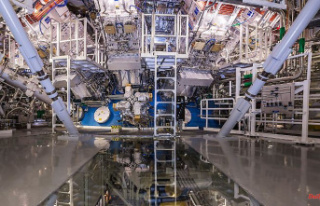No question: "Avatar: The Way of Water" is bombastic. For more than three hours, James Cameron fires on all cylinders, which is what film technology has to offer these days. But a good film also needs a good story, otherwise there is a risk of shipwreck. The director already seems to be running out of ideas.
"More cinema is not possible," promises the advertisement for "Avatar: The Way of Water". And indeed: the film is undoubtedly the cinema highlight of the year. It has been 13 years since the original film, Avatar, took the screens by storm. 13 years since director James Cameron introduced the audience to the fantastic world of the Na'vi. 13 years since he seemed to revolutionize cinema with hitherto unique animation art and 3D perfection. And 13 years in which the strip became the most successful film of all time.
But that's not the only reason why the expectations of the successor are huge. They were fueled by the director and his team themselves, who gave the impression that they had an almost endless reservoir of ingenious ideas at their disposal to easily continue "Avatar" for decades to come. Parts 3 and 4 should already be in the box. A fifth film is already being planned. In theory, Cameron explained that he could continue "Avatar" until the end of the day, if there wasn't a biological limit for him. The director is now 68 years old.
But 13 years is a long time. What seemed revolutionary in 2009 is already yesterday. At the same time, a kind of counter-revolution has spread since the "Avatar" premiere. In any case, the 3D hype has cooled down quite a bit in the meantime. The "Departure for Pandora" has not become a general departure into the third dimension.
Cameron, however, seems to want to punish all other lies with "Avatar: The Way of Water". Like the original, the sequel was shot in "real" 3D for the XXL IMAX format and not converted afterwards. As far as 3D technology is concerned, not too much has happened since 2009 - at least from the viewer's point of view - no matter how many additional frames per second have rattled through since then. The situation is different in the areas of animation and performance capture - the computer-assisted recording of movement sequences and facial expressions. Here the development is still making perceived quantum leaps.
Quantum leaps that you can see in "Avatar: The Way of Water". The film sounds a bit like a tour of the IFA, where you take a look at what the hottest shit is on the electronics market right now. Cameron really fires from all cylinders with what the film technology currently has to offer. And that is nothing less than the final transition from computer game aesthetics to photorealism. As if the blue Na'vi creatures with the wide eyes, pointy ears and tails were actually flesh and blood beings whose four-fingered hands could be shaken. Or as if the fantastic picture book world of Pandora could really be found somewhere on a neighboring planet. The whole thing in high resolution in 4K - and over a total film duration of more than three hours.
The question of whether or not you can have fun on a three-hour IFA walk is something everyone has to answer for themselves. But Cameron really does everything to keep you from getting bored. In particular, the underwater worlds he has created are truly phenomenal. A special coup is certainly that he brings the now 73-year-old Sigourney Weaver, whose character died in the first "Avatar" film, a comeback in the role of a Na'vi teenager (!). The only thing that he seems to have completely forgotten about this whole technical performance show is what is inevitably part of a really great film: a good story and a meaningful plot.
You look for them in "Avatar: The Way of Water" but unfortunately in vain. Instead, the film essentially focuses on telling the story of its predecessor again in a simplified form. The big foil in which "Avatar" once brought together spirituality and materialism, peaceful civilization and brutal oppression, harmony with nature and capitalist exploitation, shrinks to the personal feud between Jake Sully (Sam Worthington) and Colonel Miles Quaritch ( Stephen Lang), who is also allowed to return as a cloned villain after his death in the first part. What remains at the end is a rather simple Wild West story, as if Santer were blowing his revenge campaign against Winnetou with the entire cavalry. Only with the difference that the story does not take place in Death Valley but on Pandora, with blue Na'vis instead of "palefaces" and "redskins".
It not only lacks originality, but also logic. Because just as the cavalry would not have joined Santer, the question arises as to why the entire company, which actually only wants to exploit Pandora, is putting itself at the service of a clone's thirst for revenge. Especially since Sully actually gave in long ago and fled into exile with his wife Neytiri (Zoe Saldana) and his children among the people of the Metkayina who are connected to the sea ...
With "Avatar" Cameron once pushed himself from the throne. After all, he is also the creator of "Titanic", which previously topped the list of the highest-grossing films of all time for years. Cameron is in his element in the water. Revealing that "Avatar: The Way of Water" also evokes some "Titanic" memories shouldn't be spoiled too much.
One can only hope that Cameron doesn't experience a personal Titanic moment with "Avatar". Maybe he and his comrades-in-arms have already missed their weakest script with part two and the really brilliant ideas are still to come to fill the franchise with life apart from technical excellence. Or with soul, as the Na'vi would surely put it. But if it all comes down to it - and "Avatar: The Way of Water" makes us suspect this to a certain extent - simply reproducing the story over and over again, Cameron is threatened with shipwreck. More cinema is not possible? That would really be a pity.












